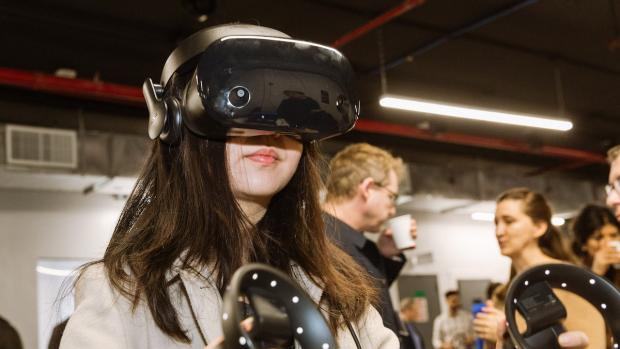New Tandon-Led RLab Launches at the Brooklyn Navy Yard

On October 24, the third floor of Building 22 at the Brooklyn Navy Yard became the site of an exciting new facility that promises to change reality for hundreds of job-seeking New Yorkers and make the city a world leader in augmented- and virtual-reality (AR/VR) technology.
That day, the RLab, the first city-funded AR/VR center in the nation, opened its doors, and hundreds of attendees from across the area came to celebrate and see the technology in action.
By the Numbers
Investment by the NYC Economic Development Corporation and Mayor’s Office of Media and Entertainment in the RLab: $5.6 million
Co-working spaces, classrooms, and studios: 16,500 square feet
Projected jobs created for New Yorkers: 750
Global revenues for AR/VR in 2017: $11.4 billion
Projected global revenues for AR/VR by 2021: $215 billion
The Speakers
From the appreciative buzz of those viewing the demos to the inspiring words of the luminaries in attendance, the excitement at the launch event was apparent — and audible.
This is a proud day for Tandon and all of our RLab partners. We’re seeing an example of our expanding role in New York City’s tech ecosystem and proof that we’re extending Brooklyn’s Tech Triangle into a full Innovation Coastline. This will be a place of discovery and of job creation, and it will one day make New York City an epicenter for things we can’t even envision today.” — NYU Tandon Dean Jelena Kovačević
In addition to building new ventures, rethinking existing ones, and mounting strong educational programs, one of the core missions of the RLab is to build a broad and thriving AR/VR community; our launch today, with all of you here to support us, is an example of what that community might look like.” — RLab Director Justin Hendrix
New York City is a unique ecosystem with a cross-pollination of many industries, and AR/VR is a good example. While you may immediately think of its gaming applications, it’s so much more than that. AR/VR will touch fields from medicine to architecture, and thanks to the energy and dynamism of the RLab, New Yorkers will be the ones creating the future of the technology.” — Commissioner of Mayor’s Office of Media and Entertainment Julie Menin
The RLab is a great example of what public-private partnerships can accomplish, and we expect it to shape economic growth across many sectors in all five boroughs.” — EVP and Chief Strategy Officer of NYC Economic Development Corporation Ana Ariño
Senator Daniel Patrick Moynihan once said, ‘If you want to build a great city, create a great university and wait 200 years.’ Well New York has built many great universities, and we’re seeing the results now in initiatives like the RLab. Here at the Navy Yard, if I had looked out a window a century ago, I would have seen them building battleships; today I look out and see innovative, forward-thinking, diverse technologies being developed.” — President and CEO of Brooklyn Navy Yard Development Corp. David Ehrenberg
NYU Tandon Projects on Display
In addition to high-profile media companies like the New York Times, Viacom, and NBCUniversal, which were displaying their use of AR/VR to deliver immersive news and entertainment, the launch featured companies creating educational apps, games, and more. Student and faculty researchers from NYU Tandon were well-represented, with a variety of intersectional projects touching upon everything from art and architecture to robotics and mobility.
3D Object Recognition
Want to bring a toy to life with 3D content, overlay a virtual user manual right on top of a consumer electronic device, or lead a new employee through an interactive training session? All that is possible thanks to the Vuforia SDK platform, and Tandon students are diving deep to harness its power to do even more.
Lights, Camera, Action
We’ve all been guilty of strolling while staring at our mobile devices, but now we can follow along with an AR movie that places us at the center of a free-roaming narrative adventure.
Craft
One of the 10 companies selected for the RLab’s inaugural bootcamp program, Craft is a VR program that allows the disabled or elderly to use head movements and voice commands rather than a controller to accessibly create artworks.
What Do You Get When You Cross Architecture, VR, and Biometric Sensors?
The answer is a way to measure human reaction to the built environment and a possible path to creating more human-centered, responsive work sites and living arrangements.
Do the Robot!
NYU Tandon researchers are exploring ways to use AR and VR interfaces to interact with and control planar robots.
Tōhoku
In 2011 lecturer Dana Karwas experienced firsthand the 9.1 Tohoku earthquake that shook Japan. Sheltered in the basement of a Tokyo skyscraper, she was forced to emotionally process what it felt like to be in the midst of one of the largest earthquakes ever recorded. “Tōhoku” is an artwork that resulted from what she calls a “data visceralization” process, allowing viewers to get a sense of the earthquake as expressed as a massive, gestural abstract painting.
Unseen Media
An AR-enabled tabletop game developed by Tandon alum and UX designer Brian Hui.
Other NYU Projects
CAVE
Go back in time thousands of years and join Ayara, a compelling fictional character, on her journeys. Evocative of the narrative arc of early cave paintings, CAVE combines binaural audio and mixed reality for a unique cinematic experience.
GeoPipe
GeoPipe’s creators have employed machine-learning techniques to build virtual (and highly customizable) copies of actual cities that can be used for a variety of purposes – including training autonomous vehicles.




